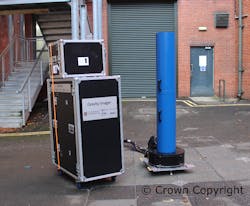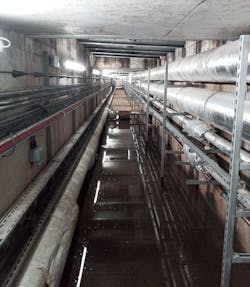Quantum gravity gradient sensor detects outdoor tunnel
By measuring small variations in the Earth’s gravitational field, it is possible to gain useful information about what lies underground. This can be used for a range of applications including mineral and resource exploration, aquifers, geological mapping, civil engineering, and archaeology. When used for these applications, the advantage of gravity sensing is the intervening media does not attenuate gravity—the range of what can be detected is limited by the sensitivity of the sensor used and not the ground conditions. Despite the advantages of gravity measurements, gravity sensors are used infrequently due to commercial considerations.
Existing gravity sensors are sensitive to vibration, tilt, and drift over time, which can severely limit the speed and usefulness of surveys. This is due to the need to integrate ground vibrations, which are often 10–100X larger than the signal of interest, align the instrument to better than 1/1000th of a degree, and perform repeated measurements on the same point during the course of a survey to remove drift. These limitations mean existing spring-based gravimeters are slow compared to other geophysical sensors.
Gravity sensing is typically only used for jobs where other geophysical sensors would fail to deliver the information required. For example, when ground penetrating radar is not effective because of ground conditions.
Cold atom- and quantum technology-based gravity sensors have shown unprecedented performance in labs around the world, and their inherent low drift1 offers a route to solving the limitations currently present in existing gravity sensors. Here, we discuss the first demonstration of a quantum technology-based gravity gradient sensor to detect a subsurface feature in an outdoor environment.2
Gravity gradient sensor
The University of Birmingham, as part of the UK’s Quantum Technology Hub for Sensors and Metrology, developed a new gravity gradient sensor to overcome the aforementioned challenges (see Fig. 1).
The sensor operates by creating two clouds of ultracold rubidium atoms held in separate magneto-optical traps in an hourglass configuration. The clouds are positioned so one is 1 m above the other. Each cloud is then cooled to millikelvin temperatures before being released simultaneously, at which point the clouds undergo freefall inside the vacuum chamber. During freefall, a sequence of counterpropagating laser pulses is fired at the clouds to create two atom interferometers that can each measure the local acceleration due to gravity. The difference in local gravity between the two clouds is extracted from the experiment.
As part of this subtraction, common noise to both atom interferometers such as vibration is removed. In addition to the common mode suppression of noise sources, this subtraction means misalignments from the vertical are correlated for the pair of clouds, giving a reduced susceptibility to tilt misalignment.
The laser system is a critical subsystem within the sensor and must provide stable high-power, narrow linewidth light via a series of pulses. Each of these pulses need to be precisely timed and delivered with particular polarizations, powers, and frequencies, all while being robust to instrument movement and environmental conditions.
To achieve this, the current iteration of the laser system is mainly composed of fiber-connected frequency-doubled telecom technology, which allows for a robust and transportable instrument. The optical power from the seed laser is amplified by erbium-doped amplifier modules; the light is switched on and off with acousto-optic modulators. The frequency of the laser is controlled by electro-optic modulators, and prior to its use on the atoms the wavelength is converted from 1560 nm to 780 nm by second harmonic generation using periodically poled lithium niobate crystals.
The sensitivity and stability of the instrument was evaluated in static operation outdoors at a measurement rate of 0.7 Hz and found to have a statistical uncertainty of 20 E within 10 min of measurement time. This is equivalent to a 1.4 ng uncertainty for each of its two gravimeters and surpasses the reported performance of commercial gravimeters for survey applications by a factor of 1.5–4.3
Feature detection
As part of the Innovate UK-funded Gravity Pioneer project to demonstrate the sensor’s potential for gravity cartography, it was trialed outdoors over a buried feature. To test the sensor, a 0.5 m spatial resolution survey was performed along an 8.5 m survey line above a pre-existing multi-utility tunnel under a road on the University of Birmingham’s campus (see Fig. 2). The tunnel itself had a 2 × 2 m internal cross-section and a reinforced concrete wall of approximately 0.2-m thickness. The sensor detected the tunnel with a signal-to-noise ratio of 8, and through the use of inference on the data, the horizontal position of the tunnel center was deduced to (0.19 ± 0.19) m along the survey line and a depth to the center of (1.89−0.59/+2.3) m.This result is the first demonstration of submeter-resolution mapping with a quantum gravity sensor. The repeatability of the prototype during the survey was similar to that of commercial gravimeters and was limited by systematic effects. Its accuracy locating the tunnel would also be extremely useful for a range of applications, including civil engineering.
Future outlook
The reduced drift, reduced susceptibility to tilt misalignment, and removal of vibration noise enables this sensor to overcome the limiting factors of existing gravity measurements, opening up not only faster measurement times, but opportunities to use gravity sensing in environments where vibrational noise would have either resulted in a high level of complication or made existing gravity sensors unusable.
While the performance of the sensor demonstrated here is suitable for many geophysical applications, the full potential of quantum gravity gradient sensors has not yet been reached. Through implementation of further scientific enhancements to the sensor and engineering improvements, there is potential to provide a further 10- to 100-fold improvement in instrument sensitivity, allowing faster mapping or detection of smaller and deeper features. It is expected such performance will be achieved in practical instruments within the next 5–10 years.
When quantum gravity gradient sensors become widely commercially available, it will be possible to map out the world beneath our feet in unprecedented detail. These sensors could be used in a diverse array of applications, including performing noninvasive surveys of archaeological sites, charting complex cave systems, measuring the time-varying flow of groundwater, and reducing the risks of unforeseen ground conditions ahead of construction and infrastructure projects.
ACKNOWLEDGEMENTS
The work described in this article was supported by the EPSRC (EP/M013294/1 and EP/T001046/1) and Innovate UK (104613), and under a contract with the Ministry of Defence, as part of the UK National Quantum Technologies Programme. The author would also like to acknowledge the work of the other authors of the paper in which these results are presented.2
REFERENCES
1. K. Bongs et al., Nat. Rev. Phys., 1, 731–739 (2019); https://doi.org/10.1038/s42254-019-0117-4.
2. B. Stray et al., Nature, 602, 590–594 (2022); https://doi.org/10.1038/s41586-021-04315-3.
3. D. Boddice et al., J. Appl. Geophys., 152, 221–235 (2018); https://doi.org/10.1016/j.jappgeo.2018.03.022.
About the Author
Jamie Vovrosh
Research Fellow, School of Physics and Astronomy at the University of Birmingham
Dr. Jamie Vovrosh is a Research Fellow within the School of Physics and Astronomy at the University of Birmingham. He leads the development of the portable cold atom gravity gradiometers within the Atom Interferometry research group. His work focuses on development of quantum sensors based on cold atoms, with a particular focus on developing field devices and new concepts for high-sensitivity devices. Prior to joining the University of Birmingham, he conducted his PhD at the University of Southampton, studying the control and manipulation of levitated nanoparticles.

